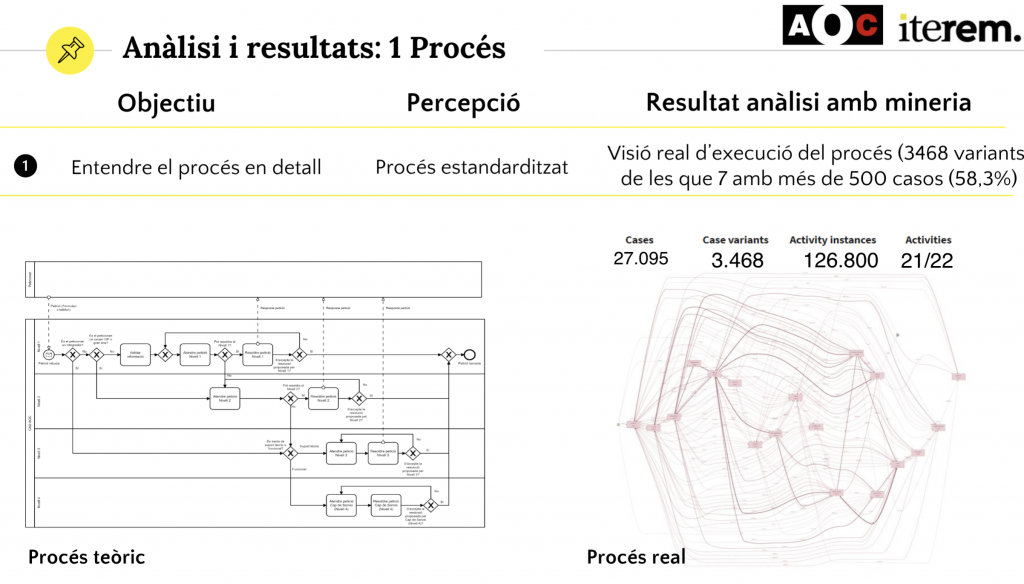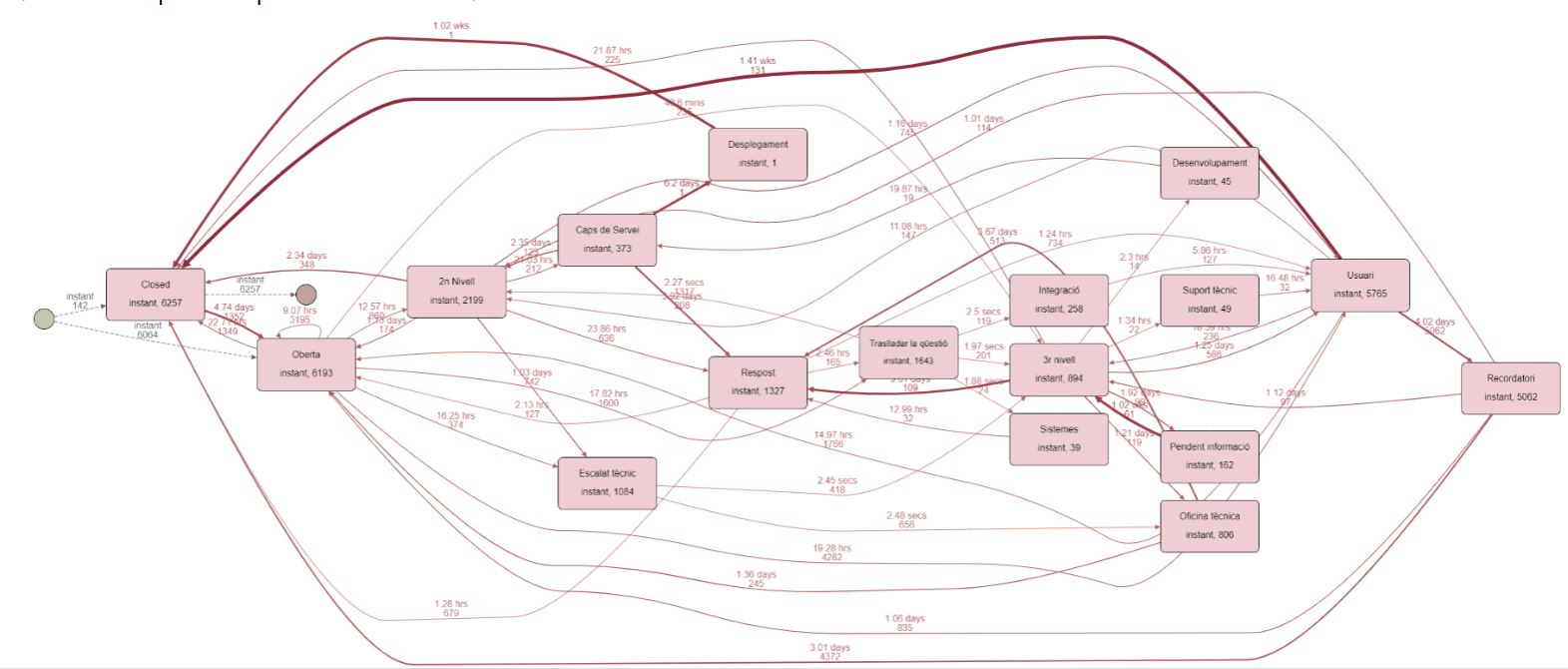Challenge
How to quickly identify points of improvement in the operation of the support service and determine the action that will have the best impact on user satisfaction.
Problematic
The AOC Consortium offers support to users through the User Service Center (CAU) from where administrations, citizens and companies can address requests and queries related to the AOC Consortium's services. The growth in recent years of the activity of the AOC services themselves, accentuated by the widespread rise of digital procedures due to the COVID-19 pandemic, has also caused this support to grow continuously since its beginning, both in volume of requests and in actors involved
:
Currently, the service already exceeds 60.000 annual support requests and includes the participation of different units of the AOC Consortium, technical offices and external suppliers. This diverse participation, multiplied by the volume of the type of services, generates a wide variety of possible processing flows of support requests, as well as a complex verification of compliance with response and resolution times.
For this reason, the need to analyze the operations of the support service processes was considered in order to:
- Measure the performance times towards the people and entities using the service
- Identify possible areas of improvement (in relation to organizational changes or technological support of the process)
- Be able to measure the impact of the proposed actions in relation to the improvement areas
- Being able to assess what would be the future impact resulting from changes in demand (as was the effect of the pandemic)
Applied solution
Carry out one
advanced analysis of the processes of the applicable support service
process mining.
What is process mining?
Process mining is a set of methods that allow you to analyze the logs of the execution of a process (in this case the support service process) using different types of visualizations to identify bottlenecks, deviations and at the same time discover opportunities to optimize performance and maximize results.
Process mining, like data mining, relies on data analysis as a fundamental pillar of analytical capabilities; but process mining goes beyond the simple processing of data and incorporates deep knowledge of the process from which it comes. In other words, the HOW (the process) is added to the WHAT (the data), which allows us to understand how the REAL operation takes place (real effort, real cost, real response times, …)
Thus, the AOC has conducted a pilot or proof-of-value project to demonstrate the applicability and benefits of process mining in a practical environment, based on the AOC's own supporting processes, from which to be awarded
we will iterate amb the
Apromore platform.

the pilot
This is a pilot project limited to a short period of time (approximately 3 months), where an advanced analysis of the support processes has been carried out to respond to the challenge posed.
The project has been developed applying the following techniques, and with a joint and guided evaluation of the results:
- Automatic discovery of process maps and comparison between models.
- Data visualization dashboards, statistics and analytical capabilities of the Apromore platform.
- Simulation capabilities (What if...?) to establish different scenarios, evaluate the impact on the process and identify the most suitable option for process improvement.
The origin of the data to be able to apply process mining
The management of the different requests and queries of the CAU of the AOC Consortium is carried out with a tool of ticketing which is a specific platform for the management of service requests. This ticketing tool allows you to keep a detailed record of:
- registered requests
- its categorization (by registration, by priority, by service,)
- its assignment to the different actors involved in its resolution
- the timestamp for recording each request and the timestamps for assignment changes until they are resolved.
The fact of having a detailed record that allows the execution of each request to be reproduced from the beginning (from the registration of the request itself) to the end (to its resolution and acceptance by the person who registered it) was presented as a excellent opportunity to be able to execute
an advanced analysis of the support service processes with
process mining.
What have we discovered?
1.324.963 activity records have been analyzed corresponding to 306.181 support requests for an activity period from 01/01/2017 to 11/11/2021.
Applying process mining to a short period of time, we obtained the following key information for process improvement:
- The discovery of processes. The starting point of how the processes are executed allows better decisions to be made in their redesign. The support process, although from a theoretical starting point it is linear and limited, in the analyzed period it has more than 23.855 variants; which allows a starting point for review and standardization of processes.
- performance In a pre (2017 to 2019) and post (2020 and 2021) pandemic comparison, it has been verified that with a greater load of support requests in the post-pandemic period, the service has been more efficient:
- Pre-pandemic: Approximately 50.000 requests for support were handled annually.
- Post-pandemic: there have been more than 60.000 requests for support each year; reducing by up to 42,5% the average duration of requests from registration to response and closing.
- Analysis of variants. Request durations (total time from start to finish) and processing time (time when the request is not pending with third parties) have been measured, making a comparison between different services. In this way, it was possible to identify differences and how the response to requests varies depending on the different services. It has also been compared based on the escalation levels of the requests, identifying behaviors and potential measure the impact of changes in the process.
- Simulation: Not only was it possible to analyze the history to draw valuable conclusions, but it was also possible to evaluate the potential of process mining to check the impact of possible changes or improvements. In a simulation, variations were made in the number of people assigned to certain tasks and their impact on the resolution time. The question raised: "What if the second level of support always responded directly to the user instead of passing the response to the first level?". The answer: "up to 16.000 processing hours could be saved annually!"
What can we conclude?
The applicability and benefits of process mining have been demonstrated in a practical environment such as the AOC Consortium's user support service. The project has allowed:
- Have a complete view of the process and its actual execution that cannot be analyzed with other techniques.
- Only with a load of data, complex analytical calculations have been obtained that would have been costly to obtain otherwise.
- Ability to simulate to assess the impact of changes on process performance, allowing you to focus on specific modifications to maximize process improvement.
In public entities, process mining makes it possible to verify and make process metrics and performance transparent, reduce waiting times, eliminate cases that do not comply with regulations and, at an organizational level, save time in the identification and definition of processes.
One of the most common challenges is the availability and quality of data. In this case they were available and easy to extract in the tool
ticketing. It is very important that the tool or platforms used to run the operations, make this record and allow this information to be extracted if you want to minimize the effort of data preparation when tackling a process mining project.
Status of the project
Pilot completed. Advanced analysis with customer service process mining completed.
More information


